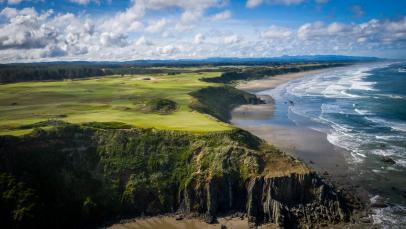Courses
The ghost tree at Old Macdonald was in danger of falling, but Bandon has secured its iconic cedar

A storm with high winds has jeopardized one of golf's most recognizable trees.
Courtesy of the resort
Extreme weather in the past week has jeopardized one of golf’s most recognizable visuals. The ghost tree at Bandon Dunes' Old Macdonald—a large, stately Port Orford Cedar situated on the third hole that can be seen from most every hole on the course—was in danger of falling down, the resort acknowledged, but it has since secured it.

A golfer tees off on the second hole at Old Mac earlier this week with the stately cedar tree looming in the distance.
Tony Shuster
Videos and photos surfaced on social media on Tuesday of the tree leaning to the north after a storm brought wind gusts of more than 70 mph to the Bandon, Ore., coastal layout. The resort researched possible solutions for stabilizing the tree earlier in the week, and then on Thursday pulled the tree back to an upright position with the help of some cables. The cables will remain to ensure its position on Old Mac's third hole.

The ghost tree in all its glory—with Bandon caddie Adam Bailey in the foreground.
Tony Shuster
The tree has become a celebrated logo of sorts for visitors to the Bandon Dunes Golf Resort, with its five top-ranked 18-hole courses. It not only serves as a target on the third hole “Sahara,” a short par 4 that rewards drives that get close to the towering cedar, but in many ways it symbolizes the mystique of the entire course. A golfer tees off to an elevated, blind fairway on the third hole—and a severely uphill walk over the sand ridge reveals one of the more awe-inspiring vistas at the resort.

The “Ghost Tree” is a lone shore pine stripped bare by wind that stands hauntingly atop a dune ridge that must be hit over some 150 yards from the tee. Its forked shape is a metaphorical Styx dividing the terrestrial logic of holes 1, 2, 17 and 18 and the surreal underworld shapes that await on the far side. It’s also a useful aiming target.
Ben Walton
Of course, this has happened with other famous trees in golf. In 2014, one of the two cypress trees in the 18th fairway at Pebble Beach toppled over in a storm with similar winds. It cost the resort an estimated $350,000 to replace the tree. Earlier that year, golf lost perhaps its most famous tree, the loblolly pine dubbed the Eisenhower Tree to the left of the 17th fairway at Augusta National. It was not replaced.
Editor's Note: This post was updated on Friday with news that the tree has been secured by the resort's grounds crew.


